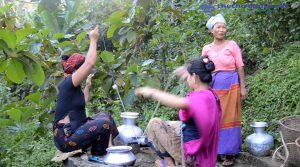A decade ago, even affluent Chinese could scarcely have imagined snacking on succulent cherries picked on the other side of the world. Today, all you have to do is visit a website to order them and half an hour later they can be delivered to your doorstep.
One of China’s biggest food importers, Shunfeng First Choice, is promoting what they describe as a dream come true: a 2.5 kilogram box of Chilean cherries for the apparently low price of 300 yuan (US$ 47).
According to the Chilean Association of Dried Fruit Exporters (Asoex, in the Spanish acronym), the South American country registered a 39% increase in fruit exports to China during the 2014-15 harvest (including Hong Kong). Around 26.5 tons of cherries made the journey from Chilean orchards to the dining tables of wealthy Chinese since becomimg an after dinner delicacy and status symbol. The greatly-anticipated Singles Day, which the Chinese celebrate on November 11, saw sales of Chilean cherries explode across the country,
Grapes are even more popular, representing 38% of all Latin America’s fruit exports to China, followed by cherries (33%), plums (12%), nectarines, peaches and apricots, apples (9% each), kiwis (5%), and blueberries (3%).
Chinese are willing to pay over the odds for Latin American fruit and Chilean producers are looking to increase production and export of fruits like nectarines and peaches to meet demand, according to president of Asoex, Ronald Bown Fernandez, who says choosing Chilean is also a good environmental option compared to other suppliers.
“Particularly in the case of apples, we have a carbon footprint similar to that of New Zealand,” Bown told Diálogo Chino.
Another environmentally positive aspect of this industry according to Bown is the high-tech maritime transport of produce in cutting-edge refrigerated containers. “Basically, they require half the energy of traditional containers and the ships have been increasing their stock capacity, which also helps to reduce the rate of greenhouse gas emissions,” he says.
But it’s not all rosy for the fruit trade. Cherries and grapes are among the crops most vulnerable to climate change in countries such as Chile, which has experienced increasingly volatile weather in recent years. Warmer temperatures affect the ripening of fruit and heavy rains have brought with them plagues of pests and fungus, which imply added input costs and greater uncertainty for crop yields.
“It’s not possible to predict what the exportable quantity of our fruits will be in 2015-16,” Bown recently told Chilean daily El Mercurio.
Fruitful trade
The Chilean governmnet is optimistic about the success its fruit in Asian markets, describing the recent boom in trade as “overwhelming”.
“Before the free trade treaty with China [signed in 2006] took effect, exports to China were virtually nil. After phytosanitary permission was granted in 2008, we saw a US$ 16 million increase in exports of cherries to China. In 2014, this number reached US$ 476 million. In other words, 80% of the cherries consumed in China come from Chile,” according to Andrés Rebolledo, director-general of the General Directorate for International Economic Relations (Direcon, in the Spanish acronym), an agency within the Chilean Ministry of Foreign Affairs.
In 2020, Chinese food imports are expected to double 2010 levels. The Communist Party’s thirteenth five-year plan aims to lay the foundations for a dramatic increase the Chinese population’s purchasing power which will be the main factor driving this greater demand, according to Andre Soares, a consultant at the Inter-American Development Bank.
Soares believes that agriculture represents the major commercial opportunity between Latin America and China in the coming years and says the current economic situation in the latter can be analysed from two different perspectives.
“There is a slowdown in China influenced by the retraction of industrial production. On the other hand, in China there is strong acceleration in consumption of food and clothing, which is driven by the increase in household disposable income,” he explains.
With regard to fruit consumption, the average Chinese person consumes five times less than the global average. While the average person in the United States spends US$ 97 per day, in China this number is is just US$ 7. Imported food products are still out of reach for about half the Chinese population. On average, the urban Chinese population consumes three times more processed foods than rural dwellers.
President of the China Entry-Exit Inspection and Quarantine Association Ge Zhirong affirms that fruits and vegetables have become an indispensable part of the daily diet in his country. “There is a huge domestic demand for fresh fruit due to increased awareness about healthy eating, as well as people’s standard of living,” he recently said in an interview with the EuroFresh Distribution website.
Because of logistical issues as well as free trade agreements, the South American countries that send the most fruit to China are Chile, Peru, and Ecuador. 232,000 tons of Ecuadorean bananas were shipped across the Pacific Ocean last year, bringing in US$ 185 million in revenue. Bananas are the only alimentary product that Ecuadorians can legally export to China, and sales have grown 35-fold over the last four years. Similar to cherries, bananas are also considered a delicacy in China and are highly sought-after by the country’s new middle classes.
Ana María Deustua, executive director of the Peruvian Association of Agricultural Producers’ Guilds, believes that five times more fruit could be sent to China, but this has not yet occurred due to food safety barriers relating to phytosanitation. “US$ 100 million worth of fruit per year is exported to China. It’s a very big market, but we still have pending issues,” she said in an interview with the website Péru 21.
The main exception is Brazil. It is the third largest fruit producer in the world, but the country does not have free trade agreements with China and phytosanitary issues bar it from sending its food production to China. “The entry of Latin American products into the Chinese market will not be automatic. But the fact is that agricultural products are the region’s main opportunity at the moment,” says Soares.






